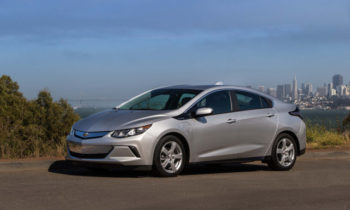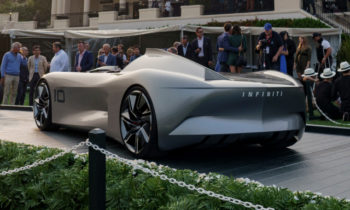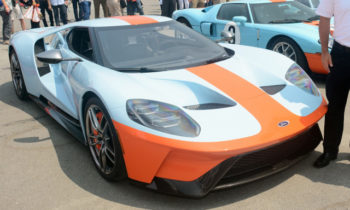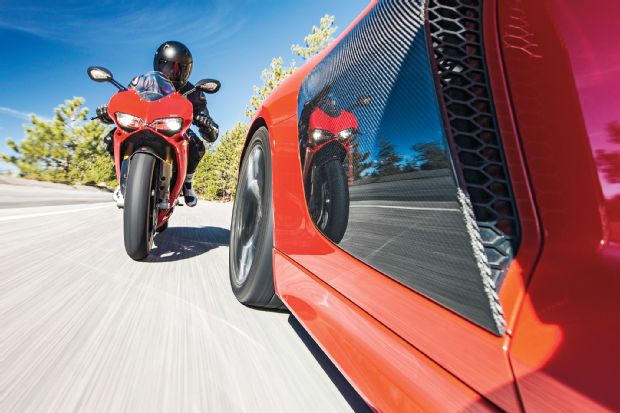
“Ducati is asking Audi for help on lighting and electronics, while Audi might pluck Ducati’s patented desmodromic valvetrain for use inhigh-revving sports cars.”
We’re here because we want to grasp why three of Germany’s most storied automakers—Audi, BMW, and Mercedes-Benz—find motorcycles attractive. BMW has built bikes longer than it has cars, Audi bought Ducati outright for a billion-plus dollars in 2012, and Mercedes-Benz recently purchased a minority stake in and a seat on the board of boutique Italian motorcycle manufacturer MV Agusta. But where does this fascination with the two-wheeled world come from, and do these relationships benefit both the car and bike builders alike?
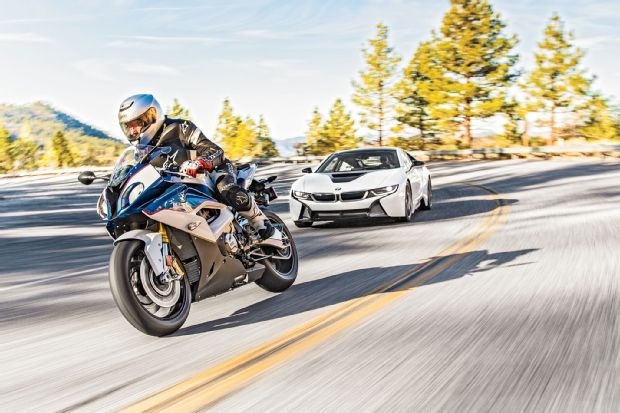
The S 1000 RR probably wouldn’t have systems such as ABS, traction control, and cruise control if it weren’t for Motorrad’s close relationship with BMW’s auto branch.
Motorrad benefits not only from the car side’s logistical network, which helps get bikes into the country and parts to dealers, but also by repurposing complex, scratch-built automotive systems such as traction control, cruise control, navigation, LED lights, and even heated seats that would be too expensive to develop for motorcycles on their own.
“Anti-lock brakes, for example, are not something we could’ve developed ourselves,” says Odwarka. “It’s gone through literally hundreds of iterations over the decades, and each time the car side has been able to augment it with its deep knowledge and technology base. Now we’re able to adapt it and use it on the motorcycle side.”
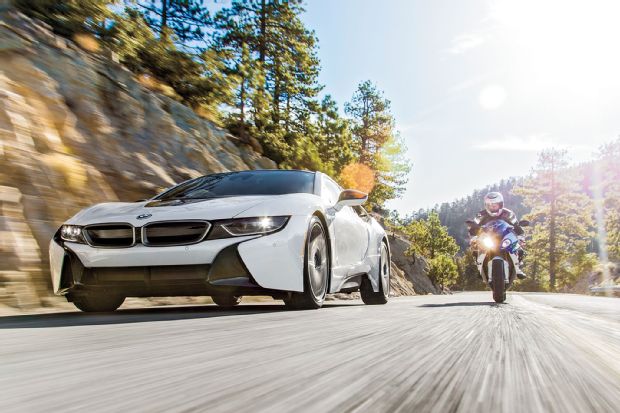
Since a motorcycle’s dynamics are far different from a car’s, tech that trickles to Motorrad often needs more tinkering, and what start as relatively simple systems for cars can become infinitely more complex for motorcycles. Adaptive headlights like the ones on the i8 typically move with inputs from a car’s steering wheel and suspension, but Motorrad had to rework them for use on bikes so they would lean and adjust depending on how much a motorcycle is heeled over. “There’s also a 3-D braking system on the S 1000 RR,” says Odwarka. “It not only focuses on yaw, but it can accurately reflect and record within thousandths of a second how you’re sliding the front and rear ends of the bike.”
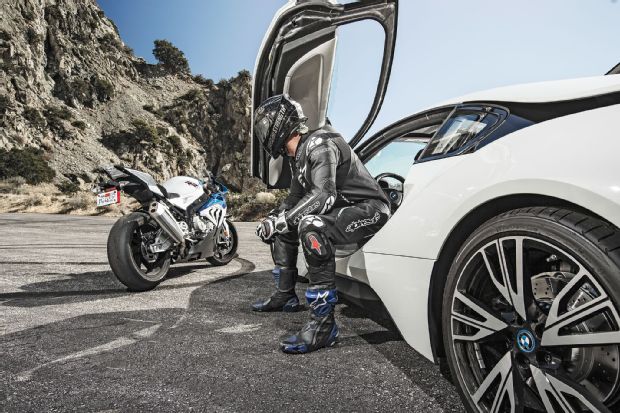
BMW loves asymmetry. The i8 is built around organic shapes, inside and out, and the left and right sides of the S 1000 RR have disparate designs. They’re both gorgeous.
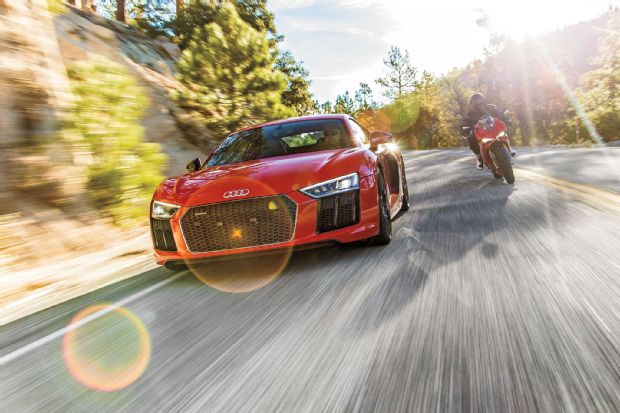
Claudio Domenicali, Ducati’s CEO, says, “That was a very important message that made our people confident that it was possible for our brand to continue and grow.” While Ducati already had a sound business model and great product portfolio, Audi brought financial solidity to the motorcycle manufacturer to improve everything from Ducati’s build quality to its dealer relationships. The automaker also quickly opened the lines of communication between the two engineering departments.
“The relationship is quite open, and there’s frequent exchange of opinion and information at many different levels,” says Domenicali. “It’s very interesting when we have a development meeting to see what can be put into production and how we can incorporate different technologies.”
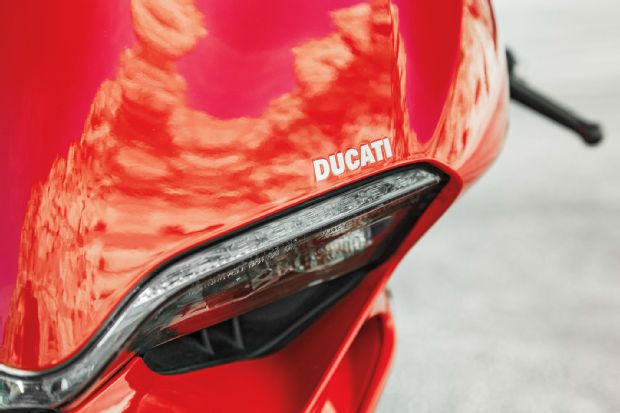
The LED headlights on the Panigale S that wrap around the top of the bike’s front air scoops are very appealing, and they’ll no doubt be even more impressive on the next-gen bike, what with Audi’s help.
It’s a new marriage, still too green to yield much of anything tangible. But the relationship is moving forward. Ducati is asking Audi for help on lighting and electronics, while Audi might pluck Ducati’s patented desmodromic valvetrain for use in high-revving sports cars. And both brands work together to reshape the on-road relationship between cars and bikes.
“The networking of cars and new driver-assistance systems, particularly for added safety in traffic, are major issues for the future of the automotive industry, so why not motorcycles as well?” asks Stadler. “A strong network of bike-to-car communication could be possible, and it’s one of the systems we’re investigating for the future,” adds Domenicali.
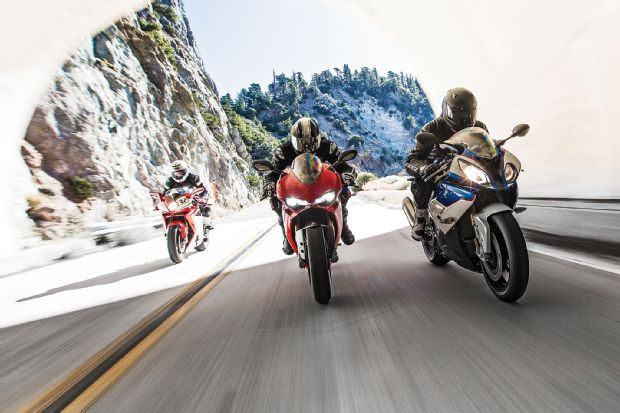
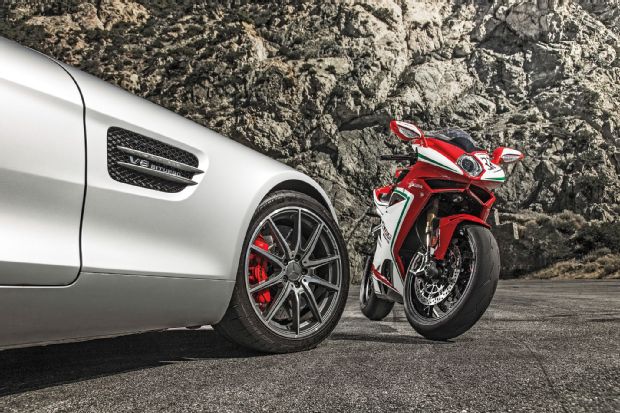
“We do everything internally—engines, frames, chassis, lights, everything,” says MV Agusta president and CEO Giovanni Castiglioni. “Our research center is the best in the industry from my point of view. We’ve developed some of the most iconic bikes of the last three decades there.”
To Castiglioni, this tie-up need not be rooted solely in marketing, and he sees plenty of opportunity to do more. “I believe Mercedes-Benz is a very cool, dynamic company, and that MV and Mercedes-AMG’s performance are a really good fit,” he says. “Potentially, what would be interesting to us would be bringing the technology of turbocharging into the bike business. Mercedes-AMG makes very good turbocharged engines, maybe the best, so for sure this is an aspect we could consider in the future, to create a midsize engine with a turbocharger that can deliver the performance of a superbike.”
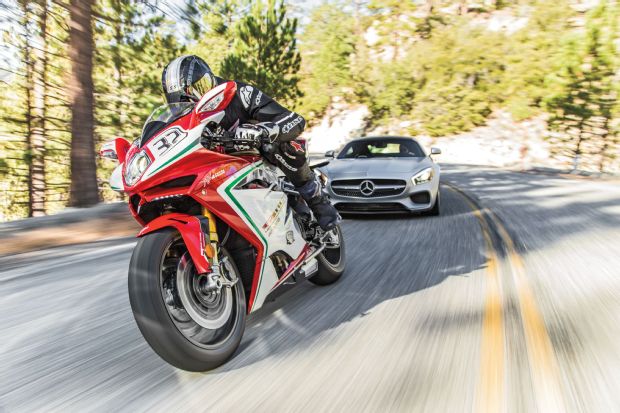
MV Agusta thinks of motorcycles as moving art. The F4 RC’s basic design is more than a decade old but still looks fantastic. It’s even better to ride. We can’t imagine how it would be with an AMG turbo piped in.
Although it is easy to understand what attracts motorcycle manufacturers to automakers—new resources, bigger budgets, and wider reach—less clear is what attracts automakers to motorcycle companies. It becomes more apparent when we stop near a lengthy tunnel at the top of Angeles Crest, and the R8, i8, and GT S pull alongside the 1299 Panigale S, S 1000 RR, and F4 RC. These two- and four-wheel machines are made from the same metal and rubber and share a lot of the same mechanicals, but they look, feel, and perform as if they were built on different planets. The purpose and character of a car is wholly different from that of a bike—even the grittiest sports car here is coddling compared to these singularly focused motorcycles.
““The motorcycle space is such a great incubator for advancing technology and is so much more extreme than anything in the automotive space.””
“Any car company would be well served in developing a relationship with a motorcycle company to leverage its technology and learn from them,” says Odwarka. “The motorcycle space is such a great incubator for advancing technology and is so much more extreme than anything in the automotive space.”
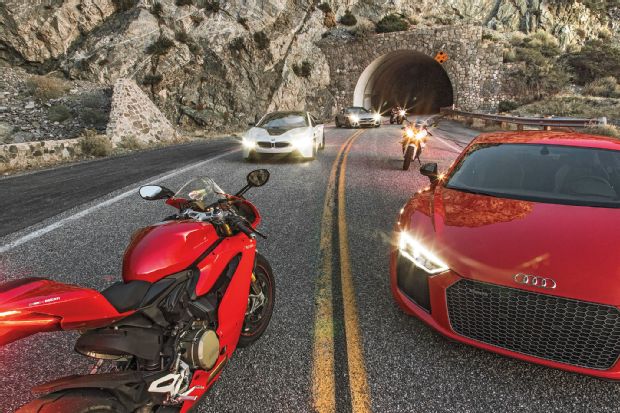
The R8’s taillights tint the tunnel’s light gray walls red as I roll the Ducati to a stop beside the purring supercar, its launch control system holding the V-10 steady. I drop my visor, look at the car I’m about to drag race, and can’t believe it’s in the same family as the bike I’m on. As BMW and Motorrad grow ever closer, Audi establishes a cadence with Ducati, and Mercedes figures out if it can have a fruitful future with MV Agusta, the attraction to motorcycles’ undiluted and unbroken
nature seems undeniable. And after a day with six of the best machines built today, it all makes perfect sense.
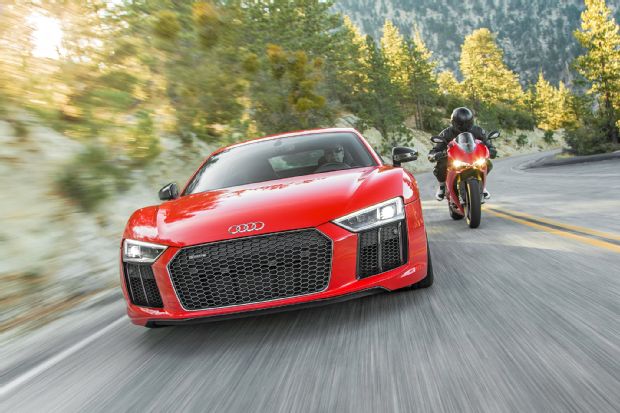
2017 Audi R8 V10 Plus Specifications
| On Sale: | Spring 2016 |
| Price: | $190,000/$230,000 (base/as tested) (est) |
| Engine: | 5.2L DOHC 40-valve V-10/610 hp @ 8,250 rpm, 413 lb-ft @ 6,500 rpm |
| Transmission: | 7-speed dual-clutch automatic |
| Layout: | 2-door, 2-passenger, mid-engine, AWD coupe |
| Fuel Mileage: | 14/23 mpg (city/hwy) (est) |
| L x W x H: | 174.3 x 76.4 x 48.8 in |
| Wheelbase: | 104.3 in |
| Weight: | 3,653 lb |
| 0-60 MPH: | 2.6 sec |
| Top Speed: | 205 mph |
2015 Ducati 1299 Panigale S Specifications
| On Sale: | Now |
| Price: | $24,995 (base) |
| Engine: | 1.3L DOHC 8-valve L-2/205 hp @ 10,500 rpm, 107 lb-ft @ 8,750 rpm |
| Transmission: | 6-speed manual |
| Layout: | 0-door, 1-passenger, mid-engine, RWD motorcycle |
| Fuel Mileage: | N/A |
| L x W x H: | 81.1 x 29.3 x 32.7 in |
| Wheelbase: | 56.6 in |
| Weight: | 420 lb |
| 0-60 MPH: | 3.0 sec (est) |
| Top Speed: | 185 mph |
2015 BMW i8 Specifications
| On Sale: | Now |
| Price: | $137,495/$150,095 (base/as tested) |
| Engine: | 1.5L turbo DOHC 12-valve I-3/228 hp @ 5,800 rpm, 236 lb-ft @ 3,700 rpm plus electric AC motor/129 hp, 184 lb-ft; 357 hp, 420 lb-ft, combined |
| Transmissions: | 6-speed automatic and 2-speed automatic |
| Layout: | 2-door, 4-passenger, mid-engine, front- and mid-motor, FWD/AWD coupe |
| EPA Mileage: | 28 mpg/76 mpge (combined) |
| L x W x H: | 184.9 x 76.5 x 50.8 in |
| Wheelbase: | 110.2 in |
| Weight: | 3,455 lb |
| 0-60 MPH: | 4.2 sec |
| Top Speed: | 155 mph |
2016 BMW S 1000 RR Specifications
| On Sale: | Now |
| Price: | $16,045/$19,790 (base/as tested) |
| Engine: | 1.0L DOHC 16-valve I-4/199 hp @ 13,500 rpm, 83 lb-ft @ 10,500 rpm |
| Transmission: | 6-speed manual |
| Layout: | 0-door, 2-passenger, mid-engine, RWD motorcycle |
| Fuel Mileage: | 39 mpg (combined) (est) |
| L x W x H: | 80.7 x 32.5 x 32.1 in |
| Wheelbase: | 56.6 in |
| Weight: | 450 lb |
| 0-60 MPH: | 3.0 sec |
| Top Speed: | 186 mph (est) |
2016 Mercedes-AMG GT S Specifications
| On Sale: | Now |
| Price: | $130,825/$153,760 (base/as tested) |
| Engine: | 4.0L twin-turbo DOHC 32-valve V-8/503 hp @ 6,000-6,500 rpm, 479 lb-ft @ 1,750-5,000 rpm |
| Transmission: | 7-speed dual-clutch automatic |
| Layout: | 2-door, 2-passenger, front-engine, RWD coupe |
| Fuel Mileage: | 16/22 mpg (city/hwy) |
| L x W x H: | 179.0 x 76.3 x 50.7 in |
| Wheelbase: | 103.5 in |
| Weight: | 3,691 lb |
| 0-60 MPH: | 3.5 sec |
| Top Speed: | 193 mph |
2015 MV Agusta F4 RC Specifications
| On Sale: | Now |
| Price: | $40,580 (base) |
| Engine: | 1.0L DOHC 16-valve I-4/205 hp @ 13,450 rpm, 85 lb-ft @ 9,300 rpm |
| Transmission: | 6-speed manual |
| Layout: | 0-door, 2-passenger, mid-engine, RWD motorcycle |
| Fuel Mileage: | N/A |
| L x W x H: | 83.3 x 29.5 x 32.7 in |
| Wheelbase: | 56.3 in |
| Weight: | 450 lb (est) |
| 0-60 MPH: | 3.0 sec (est) |
| Top Speed: | 188 mph |

